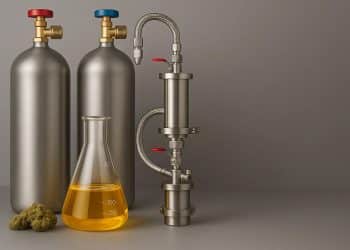While many cannabis extractors might say that you get the best terpene profiles using butane extraction, others will relate that you can do just as well with subcritical carbon dioxide (CO2) extraction. One benefit of CO2, ironically enough, is its environmentally friendly label, as it’s considered a greener solvent compared to hydrocarbons. CO2 extraction is tunable, scalable, and sustainable, making it an increasingly relevant method.
You can indeed recreate a given cannabis cultivar’s terpene profile. You just have to learn how to be gentle and patient with your extraction parameters, and how to refine your method to ensure the terps come out in the same ratios that are in the starting biomass. We recently spoke with Jesse Turner, Director of R&D at Green Mill Supercritical to learn more.
Extraction Magazine: When using pressurized extraction, what key parameters do you suggest operators of your systems use to capture terpenes? How does this differ from the tunability used for maximizing cannabinoid extraction?
Jesse Turner: I have typically employed the “low density” approach to terpene extraction. As density is the driver of compound solubility in supercritical CO2, the density used must fit the desired target compounds. For standard terpene extractions, I will target a density in the 0.300 g/mL range. This will avoid the co-extraction of plant waxes and cannabinoids and will create a higher purity mono- and sesquiterpene extract compared to a higher density subcritical CO2 extraction. Using Green Mill’s new Real-Time Winterization system, I will target a density of around 0.450 g/mL. The waxes that normally solubilize above a density of 0.350 g/mL are removed in-process and the cannabinoid co-extraction is minimized. Cannabinoid extraction densities will typically range from 0.550 g/mL up to 0.750 g/mL. Solvent densities above that range will lead to a higher solubility for the cannabinoids, but at a cost as pigments and chlorophyll degradation products begin to solubilize and the cannabinoid crude quality begins to drop.
EM: Have you seen different parameters as being most suitable when targeting fragile monoterpenes versus sesquiterpenes?
JT: The key to monoterpene extractions is to keep the extraction temps lower and to setup the collection system properly. I utilize all three of the in-line collectors on my system to collect the light volatile compounds. Essentially, the more residence time you can provide at the collection step, the better. Also, keeping the collection vessel temps low, just above the phase change point for supercritical CO2, helps in getting the monoterpenes to condense for collection. Any process where the material is subjected to prolonged heat is going to be detrimental to the monoterpene profile. I am not a believer in using any form of distillation to create a terpene product that is “true” to the plant.
EM: How can one retain the precise ratios of terpenes in the starting biomass in the subsequent extract such that an extract labeled with a specific cultivar’s name truly represents that cultivar?
JT: It requires analytics. What does the terpene profile of the starting biomass look like? What is the ratio of cannabinoids to terpenes? Conduct the targeted terpene extraction and then conduct the cannabinoid extraction, both with supercritical CO2. Recombine in the same ratio found from the initial analysis of the biomass.
EM: How does one capture the terpenes from the separator using your CO2 systems?
JT: I have found that the best way to collect terpenes is to utilize the full capacity of the post-extraction collectors. Keep the temps as low as possible and utilize either all three 3.3L vessels or at a minimum two of them to maximize the light volatile collections. This will provide anywhere from 6.6L to 9.9L of total collection volume and a big increase in residence time. Additionally, the solvent flow rate can be reduced if necessary to increase the amount residence time and to promote the target compounds to drop out during collection.
EM: When someone is attempting to optimize their extraction to best maintain terpenes in the extract, or at least the ability to add a terp fraction back into the cannabinoid fraction, what steps should they undertake to dial in the process?
JT:
- Maintaining a reproducible grind size on the biomass. This should be in the 0.25 mm to 0.50 mm size range.
- Running the same terpene specific method. Changing the method can change the output.
- Avoiding density spikes during the startup phase of the extraction. This can cause plant waxes and cannabinoids to be co-extracted.
- Keeping the solvent density below 0.300 g/mL. This will extract the terpenes and hydrosol and keep the other compounds in the plant material for a subsequent extraction.
- Having a proper collection system. It needs to be able to run lower temps (around room temp), in the gas phase, while providing sufficient residence time for the compounds to drop out of the gas stream and be collected. Systems with small volume collectors and excessive flow rates will struggle to collect the light monoterpenes.
EM: How important are terpene extractions and preservation to your clients? How do you see terpene preservation as playing a role in the cannabis market moving forward?
JT: Terpene extractions are a topic that I am constantly discussing with customers. In fact, I have learned a great deal from being able to work together with some of our customers to dial in the methodology. I do think that the topic of terpenes and terpene extractions will continue to be an important subject in the industry.












